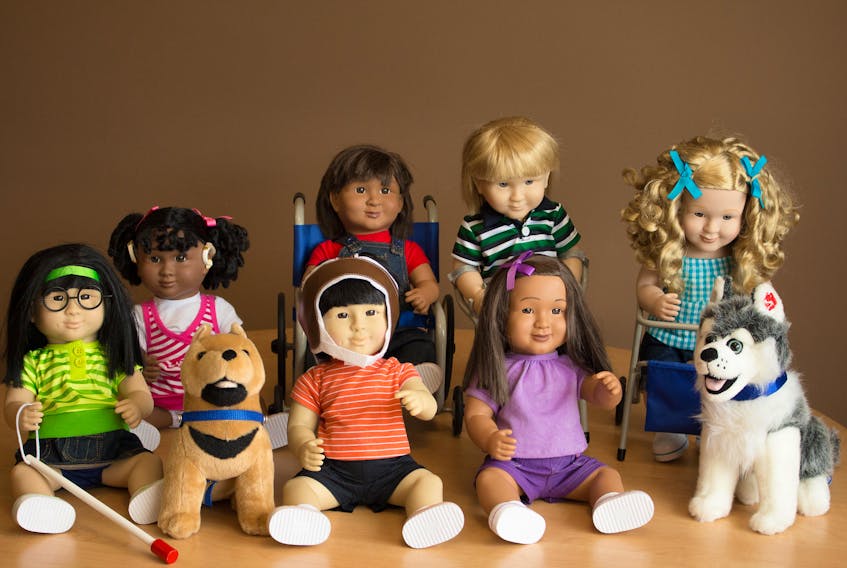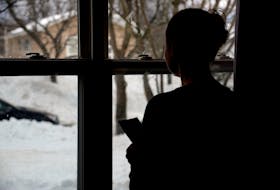Easter Seals Newfoundland and Labrador is launching a new initiative today to expand students’ awareness of disabilities.
The “I Can Too!” Disability Awareness Program has been delivering presentations to schools for almost 10 years, but the new project consists of a cast of colourful characters, each with one of the disabilities featured in the existing 45-minute in-class presentation.

The dolls currently used as a part of the presentations are similar to the popular American Girl doll. Each one has a different disability to discuss disability awareness. There is a doll that uses a wheelchair, one that uses crutches and braces, one with a guide dog, one with hearing aids, one doll with a walker, and one with an invisible disability.
Now, students will also receive a cardstock character to keep after presenters leave the classroom, in hopes that this will help to continue the conversation.
The idea was developed by presenter and Easter Seals NL communications co-ordinator Ashley Martin-Hanlon.
“What I always say is I wish I could leave a set of dolls in every single classroom that I visit, but of course that’s just not possible.”
Martin-Hanlon and her colleague, Rachel Warren, worked with product designer André Boudreau and creative designer Charles Murphy to create six child-friendly characters with disabilities, which are printed on cardstock.
“We scoured the internet for the really cool up-to-date walkers that kids are using these days, and the really cool braces that kids are using these days. I sent (André) those for inspiration, and he came back with incredible drawings.”
“What we’re hoping now is that they’ll take that character and integrate it into the classroom,” said Martin-Hanlon. “And what would they have to do to allow this person to fully participate in their classroom? Where would their desk have to be? What washroom would they use? How would they get up the stairs?”
The first classes to be offered this new project will be St. Andrew’s Elementary School students who are receiving “I Can Too!” presentations today, Feb. 5, as part of the school’s annual Diversity Celebration Week.
It’s a project that is personally important to Martin-Hanlon, who uses a wheelchair herself. She says when she went to school, she had to attend a specific school because of her disability, whereas now, she said, things have improved in terms of schools being more inclusive.
Presentations needed
It is evident in Martin-Hanlon’s everyday life that these presentations are needed.
“I go to get my groceries, and I’m, really, I’m just like every other person in their early 30s trying to reach the bag of cat food, but people stop me and they’ll tell me how great it is that I’m out getting my own groceries,” she said. “And that’s fine, and that’s wonderful, but if we could get to the point where disability was so accepted, and so recognized, that it didn’t seem particularly noteworthy that I was out getting my own groceries, that would be ideal.”
She says the program is beneficial for students with and without disabilities.
“It’s aimed at all children because persons with disabilities are able to take such a more active role in their community now due to advancements in accessibility, and advancements in medical care. People need to learn from a very young age how to interact with persons with disabilities.
“The kid with the disability gets to see themselves represented, which is great, but the other 20 in the class get to get that awareness in a fun way.”
She said she has been asked some great questions while doing these presentations.
“I’ve been asked, with great concern, that if I don’t have stairs in my house, because we established that, then I must not have an attic. And I said, ‘No, I don’t have an attic, you’re right.’ And I was asked before Christmas with great concern, ‘Well then, where do I put my Christmas tree?’
“So, I took a minute. I mean, it’s hard not to laugh, it really is, but I took a minute and I explained that I have a great big storage closet. And those questions come from such a place of innocence, and I’d really prefer that they ask me, or they ask another presenter, and get the right answer, rather than spend their whole lives wondering or be too embarrassed to ask.”
Martin-Hanlon said the main message of the presentations is that persons with disabilities can do things that someone without a disability can do, they just might have to do it somewhat differently.
“My hope is that we’ve taken some of the mystery out of disability, and that they’ve learned that anybody with a disability that they meet in the future is just a person with a disability – person first. And my main hope is that the conversation continues.”









